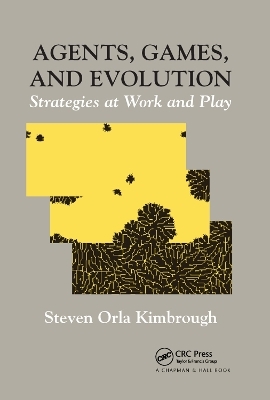
Agents, Games, and Evolution
Strategies at Work and Play
Seiten
2019
Chapman & Hall/CRC (Verlag)
978-0-367-38185-1 (ISBN)
Chapman & Hall/CRC (Verlag)
978-0-367-38185-1 (ISBN)
Games, or contexts of strategic interaction, pervade and suffuse our lives and the lives of all organisms. How are we to make sense of and cope with such situations? How should an agent play? When will and when won’t cooperation arise and be maintained? Using examples and a careful digestion of the literature, Agents, Games, and Evolution: Strategies at Work and Play addresses these encompassing themes throughout, and is organized into four parts:
Part I introduces classical game theory and strategy selection. It compares ideally rational and the "naturalist" approach used by this book, which focuses on how actual agents chose their strategies, and the effects of these strategies on model systems.
Part II explores a number of basic games, using models in which agents have fixed strategies. This section draws heavily on the substantial literature associated with the relevant application areas in the social sciences.
Part III reviews core results and applications of agent-based models in which strategic interaction is present and for which design issues have genuine practical import. This section draws heavily on the substantial literature associated with the application area to hand.
Part IV addresses miscellaneous topics in strategic interaction, including lying in negotiations, reasoning by backward induction, and evolutionary models.
Modeled after the authors’ Agents, Games, and Evolution course at the University of Pennsylvania, this book keeps mathematics to a minimum, focusing on computational strategies and useful methods for dealing with a variety of situations.
Part I introduces classical game theory and strategy selection. It compares ideally rational and the "naturalist" approach used by this book, which focuses on how actual agents chose their strategies, and the effects of these strategies on model systems.
Part II explores a number of basic games, using models in which agents have fixed strategies. This section draws heavily on the substantial literature associated with the relevant application areas in the social sciences.
Part III reviews core results and applications of agent-based models in which strategic interaction is present and for which design issues have genuine practical import. This section draws heavily on the substantial literature associated with the application area to hand.
Part IV addresses miscellaneous topics in strategic interaction, including lying in negotiations, reasoning by backward induction, and evolutionary models.
Modeled after the authors’ Agents, Games, and Evolution course at the University of Pennsylvania, this book keeps mathematics to a minimum, focusing on computational strategies and useful methods for dealing with a variety of situations.
Steven Orla Kimbrough, The Wharton School, University of Pennsylvania, Philadelphia, USA
Starters. Mixed Motives. Markets and Applications. Topics in Strategic Analysis. Appendices. Bibliography. Index.
| Erscheinungsdatum | 24.09.2019 |
|---|---|
| Sprache | englisch |
| Maße | 156 x 234 mm |
| Gewicht | 453 g |
| Themenwelt | Mathematik / Informatik ► Mathematik ► Angewandte Mathematik |
| Mathematik / Informatik ► Mathematik ► Graphentheorie | |
| Wirtschaft ► Betriebswirtschaft / Management ► Unternehmensführung / Management | |
| ISBN-10 | 0-367-38185-0 / 0367381850 |
| ISBN-13 | 978-0-367-38185-1 / 9780367381851 |
| Zustand | Neuware |
| Haben Sie eine Frage zum Produkt? |
Mehr entdecken
aus dem Bereich
aus dem Bereich
Buch | Softcover (2024)
Springer Vieweg (Verlag)
44,99 €
Anwendungen und Theorie von Funktionen, Distributionen und Tensoren
Buch | Softcover (2023)
De Gruyter Oldenbourg (Verlag)
69,95 €


